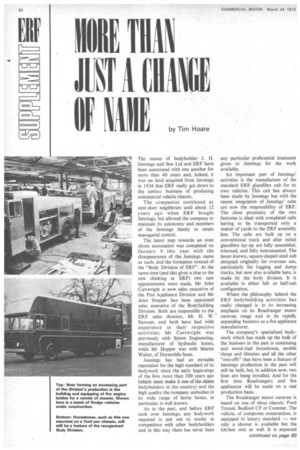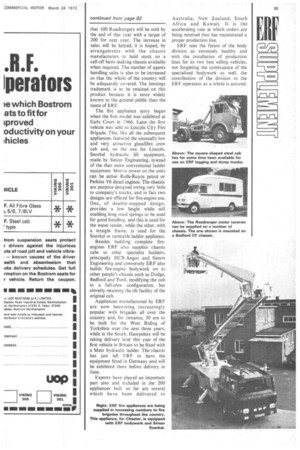HOBE THAN JUST A CHIGE
Page 84

Page 87

If you've noticed an error in this article please click here to report it so we can fix it.
OF NAME by Tim Hoare
The names of bodybuilder J. H. Jennings and Son Ltd and ERF have been associated with one another for more than 40 years and, indeed, it was on land acquired from Jennings in 1934 that ERF really got down to the serious business of producing commercial vehicle chassis.
The companies continued as next-door neighbours until about 12 years ago when ERF bought Jennings, but allowed the company to maintain its autonomy and members of the Jennings family to retain managerial control.
The latest step towards an even closer association was completed on January 9 this year with the disappearance of the Jennings name as such, itcl the formation instead of the "Body Division of ERF". At the same time (and this gives a clue to the new thinking at ERF) two new appointments were made. Mr John Cartwright is now sales executive of the Fire Appliance Division and Mr Alan Hopper has been appointed sales executive of the Bodybuilding Division. Both are responsible to the ERF sales director, Mr H. W. San sum, and both have had wide experience in their respective actiVities; Mr Cartwright was previously with Simon Engineering, manufacturer of hydraulic hoists, while Mr Hopper was with Martin Walter, of Dormobile fame.
Jennings has had an enviable reputation for the high standard of its bodywork since the early beginnings of the firm more than 200 years ago (which must make it one of the oldest bodybuilders in the country) and the high quality the company embodies in its wide range of horse boxes, in particular, is well known.
As in the past, and before ERF took over Jennings, any bodywork required is put out to tender in competition with other bodybuilders and in this way there has never been any particular preferential treatment given to Jennings for the work available.
An important part of Jennings' activities is the manufacture of the standard ERF glassfibre cab for its own vehicles. This cab has always been made by Jennings but with the recent integration of Jennings' cabs are now the responsibility of ERF. The close proximity of the two factories is ideal with completed cabs having to be transported only a matter of yards to the ERF assembly line. The cabs are built up on a conventional track and after initial glassfibre lay-up are fully assembled, trimmed, and fully instrumented. The lesser-known, square-shaped steel cab designed originally for overseas use, particularly for logging and dump trucks, but now also available here, is made by the body division. It is available in either fullor half-cab configuration.
Where the philosophy behind the ERF bodybuilding activities has really changed is in its increasing emphasis on its Roadranger motor caravan range and in its rapidly expanding business as a fire appliance manufacturer.
The company's specialized bodywork which has made up the bulk of the business in the past is continuing and wood-clad horseboxes, mobile 'shops and libraries and all the other "one-offs" that have been a feature of Jennings production in the past will still be built, but, in addition now, two lines are being installed. And for the first time Roadrangers and fire appliances will be made on a real production basis..
The Roadranger motor caravan is based on one of three chassis: Ford Transit, Bedford CF or Commer. The vehicle, of composite construction, is equipped to luxury standard — not only a shower is available but the kitchen sink as well. It is expected that 100 Roadrangers will be sold by the end of this year with a target of 200 for next year. The increase in sales will be helped, it is hoped, by arrangements with the chassis manufacturers to hold stock on a call-off basis making chassis available when required. The number of agents handling sales is also to be increased so that the whole of the country will be adequately covered. The Jennings trademark is to be retained on this product because it is more widely • known to the general public than the name of ERE.
The fire appliance story began when the first model was'exhibited at Earls Court in 1966. Later the first vehicle was sold to Lincoln City Fire Brigade. This, like all the subsequent appliances, featured the unusually low and very attractive glassfibre crew cab and, on the one for Lincoln, Snorkel hydraulic lift equipment, made by Simon Engineering, instead of the then more conventional ladder equipment. Motive power on the units can be either Rolls-Royce petrol or Perkins VS diesel engines. The chassis are purpose-designed owing very little to company's trucks, and in fact two designs are offered for fire-engine use. One, of double-stepped design, provides a low height while still enabling long road springs to be used for good handling, and this is used for the water Lender, while the other, with a straight frame, is used for the Snorkel or turntable ladder appliance.
Besides building complete fireengines ERF also supplies chassis cabs to other specialist builders, principally HCB-Angus and Simon Engineering and conversely ERF also builds fire-engine bodywork on to other people's chassis such as Dodge, Bedford and Ford, modifying the cab to a full-crew configuration, but cleverly retaining the tilt Facility of the original cab.
Appliances manufactured by ERF are now becoming increasingly popular with brigades all over the country and, For instance, 30 are to be built for the West Riding of Yorkshire over the next three years, while in the South. Hampshire will be taking delivery later this year of the first vehicle in Britain to be fitted with a Metz hydraulic ladder. Thu chassis has just left ERF to have the equipment fitted in Germany and will be exhibited there before delivery in June.
Exports have played an important part also and included in the 200 appliances built so Far are several which have been delivered to Australia, New Zealand, South Africa and Kuwait. It is the accelerating rate at which orders are being received that has necessitated a proper production line.
ERF sees the future of the body division as extremely healthy and with the installation of production lines for its two best selling vehicles, not forgetting the continuance of the specialized bodywork as well, the contribution of the division to the ERF operation as a whole is assured.




















































































































































